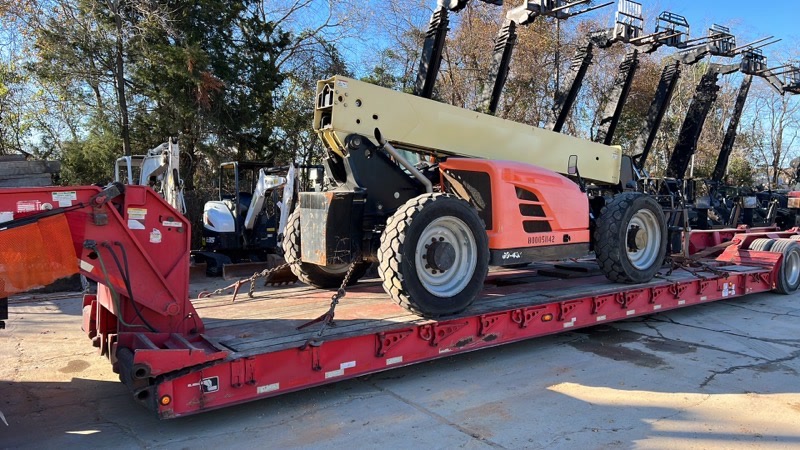How to Haul a Tractor? Learn What Trailers Can Haul Tractors?
Freedom Heavy Haul can offer expedited Pickup and Delivery for any size shipment anywhere in the USA. Contact us today for No Hassle, No Pressure Pricing.
Transporting a tractor is not just about moving heavy equipment; it’s about ensuring that this vital machinery reaches its destination safely and efficiently. In this article, you will learn how to haul a tractor and the steps of the tractor transportation process, providing detailed insights to assist both novices and experienced individuals in managing this task effectively.

Key Steps in Preparing for Tractor Transport
The journey of transporting a tractor begins long before it is loaded onto a trailer. Preparation is a multi-faceted process that starts with meticulously inspecting the tractor. This inspection should cover mechanical components, fluid levels, tire conditions, and the security of all attachments.
Ensuring the tractor is in good working order reduces the risk of transportation issues. In addition, securing the necessary documentation and understanding the legal requirements for tractor transport are crucial. This includes checking for any special permits needed based on the tractor’s size and the transportation route.
Selecting an Appropriate Trailer for Tractor Haulage
Selecting the right trailer is critical to the safety and efficiency of the transport process. The choice of trailer is influenced by the tractor’s dimensions, weight, and the specific needs of the journey. It is essential to choose a trailer that can comfortably accommodate the size and weight of the tractor, with a little extra room for securing measures.
Flat Deck vs. Low Boy Trailers
Flat deck trailers offer versatility and are often used for a range of equipment, including tractors. They are ideal for relatively lighter tractors and shorter distances. Low boy trailers, known for their lower ground clearance, are better suited for heavier, larger tractors, providing a more stable center of gravity during transport. Understanding the pros and cons of each trailer type is key in making an informed decision that ensures safety and compliance.
How to Haul a Tractor: Guidelines for Loading
The loading process requires careful planning and execution. The area used for loading should be flat and free of obstacles, providing a safe environment for maneuvering the tractor onto the trailer. Employing the correct technique for driving the tractor onto the trailer is vital to prevent tipping or damage. The process should be done slowly and cautiously, with a spotter if possible, to guide and ensure that the tractor is correctly aligned.
Securing the Tractor: Chaining Techniques
Once the tractor is positioned on the trailer, securing it firmly is the next critical step. The use of chains and straps is standard practice, with the chains strategically placed around sturdy parts of the tractor. It’s important to achieve a balance between securing the tractor tightly enough to prevent any movement, while avoiding excessive force that could cause damage. Regular checks during transport are recommended to ensure that the chains remain tight and effective.
Collaborating with Skilled Transport Drivers
The role of experienced and skilled drivers in the transportation of tractors cannot be overstated. These professionals bring invaluable expertise in handling heavy loads, navigating diverse road conditions, and responding to unexpected situations. Their knowledge contributes significantly to the safe and timely delivery of the tractor.
Detailed Procedures for Safe Tractor Loading
Safe tractor loading is a step-by-step procedure that begins with positioning the trailer in an accessible, level area. The tractor should be driven onto the trailer slowly, using the lowest gear to maintain control. Once the tractor is centered on the trailer, it should be turned off, and the parking brake should be engaged before the securing process begins.

Importance of Tractor Size in Transport Planning
The physical dimensions of the tractor play a crucial role in the planning of its transportation. Oversized tractors may require special permits, route planning to avoid low bridges or narrow roads, and sometimes even escort vehicles. Understanding these factors in advance facilitates a smoother transportation process and helps in avoiding legal complications.
Cost Analysis of Tractor Haulage per Mile
Calculating the cost of hauling a tractor involves several variables. The distance of the journey, fuel prices, driver wages, and the type of trailer used are primary factors. Additional costs may include tolls, special permit fees, and insurance. Providing an accurate per-mile estimate helps in budgeting and planning for the transport.
Time Management in Tractor Loading Operations
Efficient time management is essential in tractor loading operations. Preparation of the loading site, ensuring all necessary equipment is on hand, and having a clear plan can significantly reduce the time taken to load the tractor. Coordination among the team involved in loading and securing the tractor also plays a pivotal role in optimizing the time spent on these operations.
Support and Assistance for Tractor Shipping Queries
For those new to tractor transportation or encountering unique challenges, seeking expert advice and support is crucial. Many transport companies and industry experts offer guidance and can address specific queries related to tractor shipping. Utilizing these resources ensures a more informed and streamlined transport process.
Insurance and Liability in Tractor Transport
Navigating the intricacies of insurance and liability is a crucial aspect of tractor transport. Adequate insurance coverage is essential to protect against potential damages or accidents during transit. Understanding the scope of the insurance policy, the transporter’s liability, and any additional coverage needed is vital for both the tractor owner and the transport company.
Navigating Road Regulations and Permits for Tractor Transport
Tractor transport often involves adhering to specific road regulations and obtaining necessary permits, especially for oversized loads. These regulations can vary significantly across regions and are influenced by the tractor’s size, weight, and transport route. Ensuring all legal requirements are met is crucial to avoid fines, delays, and potential safety issues.
Post-Transport Tractor Inspection and Maintenance
Upon reaching the destination, a comprehensive inspection of the tractor is recommended. This inspection should identify any potential damages that might have occurred during transit, such as scratches, dents, or mechanical issues. Additionally, routine maintenance checks, such as fluid levels and tire pressure, should be performed to ensure that the tractor remains in optimal working condition.
Emergency Preparedness and Contingency Planning
Emergency preparedness is an often-overlooked yet vital component of tractor transport. A well-thought-out contingency plan, including emergency contacts, an essential toolkit, and knowledge of service stations along the route, is essential. This preparation helps quickly address unexpected situations such as mechanical failures, adverse weather conditions, or road closures, ensuring the safety of both the tractor and the transport personnel.







